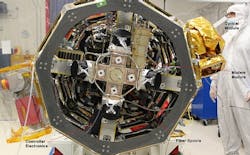NASA's first space-based laser communication system integrated, ready for launch
Moffett Field, CA--The space terminal for the Lunar Laser Communication Demonstration (LLCD), NASA's first high-data-rate laser-based space communication system, was recently integrated onto the Lunar Atmosphere and Dust Environment Explorer (LADEE) spacecraft at NASA's Ames Research Center. LLCD will demonstrate laser communications from lunar orbit to Earth at up to 622 Mbit/s (six times the rate of the best modern-day advanced radio communication systems), reaching rates similar to high-speed fiber-optic networks on Earth.
Related: NASA demonstrates laser communication between Earth and Lunar orbiter
Related: Sophisticated optical systems extend reach of free-space communications
The optical module on the space terminal consists of a telescope with a 10 cm aperture on a two-axis gimbal that will allow LLCD to maintain its link for varying spacecraft orientations. The light source is a high-peak-power fiber laser. As a side benefit, the laser link will allow the distance from the craft to the ground station on Earth to be measured to an accuracy of better than a centimeter.
Laser communication will best handle the increased data rates required for real-time communication and 3D high-definition video. For comparison, using S-band radio communications aboard the LADEE spacecraft would take 639 hours to download an average-length HD movie. With LLCD, that time would be reduced to less than eight minutes.
The LADEE mission, on which LLCD is a hosted payload, is scheduled to launch in August 2013. Data will be sent from the LADEE spacecraft by LLCD to any one of three ground telescopes in New Mexico, California, and Spain. The real challenge of LLCD will be to maintain beam-pointing accuracy over a distance of about 400,000 km while LADEE is in motion.
Related: Solar Panel contract for NASA lunar mission awarded to EMCORE
"The successful testing and integration of LLCD to LADEE is a major accomplishment," says Donald Cornwell, LLCD mission manager at NASA's Goddard Space Flight Center (Greenbelt, MD). "It demonstrates that this new technology is robust and ready for space. This is the first time NASA has had such a communication system pass all its tests and be certified flight ready."
About the Author
John Wallace
Senior Technical Editor (1998-2022)
John Wallace was with Laser Focus World for nearly 25 years, retiring in late June 2022. He obtained a bachelor's degree in mechanical engineering and physics at Rutgers University and a master's in optical engineering at the University of Rochester. Before becoming an editor, John worked as an engineer at RCA, Exxon, Eastman Kodak, and GCA Corporation.

